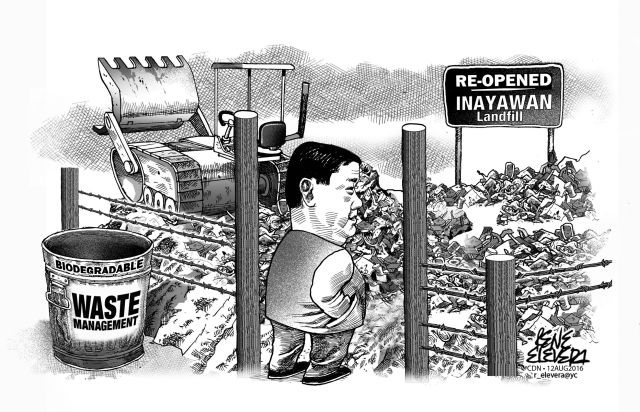
A two-part report in Cebu Daily News on the state of Cebu City’s garbage problem showed three factors that contributed to its current condition: lack of trucks and personnel, lack of discipline in implementing a genuine waste segregation program and the absence of a fully functional landfill.
And for this, we can look back at the time when former Cebu City mayor Michael Rama ordered the closure of the Inayawan landfill, in keeping with a directive from the Department of Environment and Natural Resources (DENR) to close it down because the area had in fact exceeded its maximum capacity since 2005.
The sight of mountains of garbage piled up, looking like it was ready to collapse at a moment’s notice, would seriously give pause to any plan by the city government to reopen the landfill.
And Rama didn’t exactly lack for plans to deal with the garbage problem. He had this facility donated by the Japanese government that was supposed to process plastic into fluff fuel to be sold to construction companies at competitive prices, thereby providing additional revenue to the city government and employment to some workers.
There was also his plan to negotiate with another local government to accommodate the city’s garbage since he believed that any world class and ecologically sustainable city should not have a garbage dump within its area in the first place.
Alas, Rama’s vision didn’t exactly meet reality as he failed to make a deal with the Talisay City government to dump the city’s garbage there and the cost of transporting the city’s garbage all the way to Consolacion town’s private landfill facility kept mounting.
Cebu City Mayor Tomas Osmeña was just being practical when he reopened the Inayawan landfill, but even he must realize the need for a new landfill site before his term ends.
Noted environmental advocate and former city councilor Nida Cabrera was given the unenviable task along with former councilor Roberto Cabarrubias to extend the Inayawan landfill site’s capacity to two more years.
Cabarrubias has admitted there were plans beyond the landfill but he would not say much about it, apparently upon Osmeña’s instructions.
Until the city government finds a new one, Cebu City households and businesses should do their part to ease the garbage volume.
This entails discipline on the part of the households, for them to segregate their garbage for easier collections. To this day, however, the city’s waste segregation ordinance has not been followed.
Cebu City residents can make a difference and turn the situation around by taking waste segregation seriously. The city government should also intensify its waste segregation program to help maximize the landfill’s capacity.